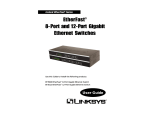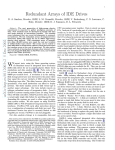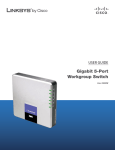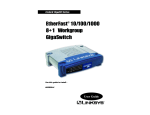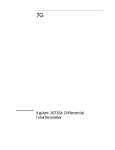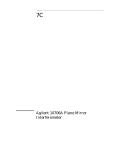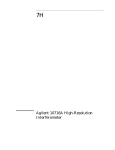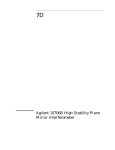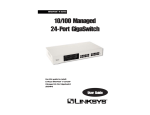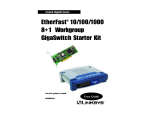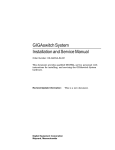Download Linksys EG0008 Switch User Manual
Transcript
Instant Gigabit™ Series EtherFast® 10/100/1000 8-Port GigaSwitch Use this guide to install : EG0008 User Guide COPYRIGHT & TRADEMARKS Copyright © 2001 Linksys, All Rights Reserved. EtherFast is a registered trademark of Linksys. Microsoft, Windows, and the Windows logo are registered trademarks of Microsoft Corporation. All other trademarks and brand names are the property of their respective proprietors. LIMITED WARRANTY Linksys guarantees that every EtherFast® 10/100/1000 8-Port GigaSwitch is free from physical defects in material and workmanship under normal use for ONE year from the date of purchase. If the product proves defective during this warranty period, call Linksys Customer Support in order to obtain a Return Authorization number. BE SURE TO HAVE YOUR PROOF OF PURCHASE AND A BARCODE FROM THE PRODUCT’S PACKAGING ON HAND WHEN CALLING. RETURN REQUESTS CANNOT BE PROCESSED WITHOUT PROOF OF PURCHASE. When returning a product, mark the Return Authorization Number clearly on the outside of the package and include your original proof of purchase. All customers located outside of the United States of America and Canada shall be held responsible for shipping and handling charges. IN NO EVENT SHALL LINKSYS’ LIABILITY EXCEED THE PRICE PAID FOR THE PRODUCT FROM DIRECT, INDIRECT, SPECIAL, INCIDENTAL, OR CONSEQUENTIAL DAMAGES RESULTING FROM THE USE OF THE PRODUCT, ITS ACCOMPANYING SOFTWARE, OR ITS DOCUMENTATION. LINKSYS OFFERS NO REFUNDS FOR ITS PRODUCTS. TAMPERING WITH OR DISASSEMBLING THE PRODUCT VOIDS THE LINKSYS WARRANTY. Linksys makes no warranty or representation, expressed, implied, or statutory, with respect to its products or the contents or use of this documentation and all accompanying software, and specifically disclaims its quality, performance, merchantability, or fitness for any particular purpose. Linksys reserves the right to revise or update its products, software, or documentation without obligation to notify any individual or entity. Please direct all inquiries to: Linksys P.O. Box 18558, Irvine, CA 92623. FCC STATEMENT The EtherFast® 10/100/1000 8-Port GigaSwitch has been tested and found to comply with the limits for a Class A digital device, pursuant to Part 15 of the FCC Rules. These limits are designed to provide reasonable protection against harmful interference in a residential installation. This equipment generates, uses, and can radiate radio frequency energy and, if not installed and used according to the instructions, may cause harmful interference to radio communications. However, there is no guarantee that interference will not occur in a particular installation. If this equipment does cause harmful interference to radio or television reception, which is found by turning the equipment off and on, the user is encouraged to try to correct the interference by one or more of the following measures: • • • • Reorient or relocate the receiving antenna Increase the separation between the equipment or device Connect the equipment to an outlet other than the receiver’s Consult a dealer or an experienced radio/TV technician for assistance UG-EG0008-10711A DG Instant Gigabit™ Series Contents EtherFast® 10/100/1000 8-Port GigaSwitch Introduction Introduction Your EtherFast®10/100/1000 8-Port GigaSwitch Features Package Contents 1 1 1 2 Getting to Know the EtherFast® 10/100/1000 8-Port GigaSwitch The 10/100/1000 8-Port GigaSwitch’s Rear Panel The 10/100/1000 8-Port GigaSwitch’s Front Panel Switches Versus Hubs 3 3 3 5 Installing the EtherFast® 10/100/1000 8-Port GigaSwitch Overview Installing the 10/100/1000 8-Port GigaSwitch Connecting Your Hardware Together and Booting Up Tips on Switching Your Network 6 6 6 6 7 Glossary 8 Specifications Environmental 12 12 Warranty Information 13 Contact Information 14 Your EtherFast® 10/100/1000 8-Port GigaSwitch st® 10/100/1000 8-Port GigaSwitch Congratulations on purchasing your new Linksys EtherFast® 10/100/1000 8Port GigaSwitch for your network's 10/100/1000 migration needs. The new standard in networking is here! The EtherFast® 10/100/1000 8-Port GigaSwitch allows you to take your network to a whole new level of productivity—and you can do it using you existing architecture. There’s no need to abandon your present equipment or radically change your way of doing things. This new GigaSwitch from Linksys allows you to do what you already do well—just faster! Apply this switching power to your current Ethernet network, and your data traffic efficiency will improve several times over. Connect your Gigabitequipped workstations to the Switch's 10/100/1000 ports for full-duplex, dedicated bandwidth of up to 2000Mbps—the speed is yours! With the EtherFast®10/100/1000 8-Port GigaSwitch, you can connect your existing 10/100 Ethernet network to your Gigabit server backbone without any additional equipment. In addition, the Gigaswitch has easy, hassle-free setup with no configuration required. The EtherFast® 10/100/1000 8-Port GigaSwitch from Linksys is an all-in-one solution for both Gigabit and Fast Ethernet networking needs. Features • 8 Port 10/100/1000Mbps Auto-Detect Half/Full Duplex Switch Ports • Head of Line Blocking Prevention • Up to 8K MAC Addresses Table/Hashing Algorithm on Address Learning • Support Store and Forward Architecture and Performs Forwarding and Filtering at Non-blocking Full Wire Speed • Supports Aging Function and 802.3x Flow Control for Full Duplex and Back-Pressure Function for Half-Duplex Operation • Supports Congestion Flow Control • Provides 6 LEDs per Port to Indicate the Packets Traffic Pattern and Link Status • Signal Regeneration Ensures Data Transfer Integrity • Free Technical Support—24 Hours a Day, 7 Days a Week for North America Only • One-Year Limited Warranty 1 Instant Gigabit™ Series Package Contents EtherFast® 10/100/1000 8-Port GigaSwitch Getting to Know the EtherFast® 10/100/1000 8-Port GigaSwitch The 10/100/1000 8-Port GigaSwitch’s Rear Panel The 8-Port GigaSwitch’s Power Connection Power • • • • One 10/100/1000 8-Port GigaSwitch One AC Power Cord Mounting Brackets and Screws (not pictured) One User Guide and Registration Card The 10/100/1000 8-Port GigaSwitch’s Front Panel Ports 1-8 2 The Power port is where you will connect the included power cord. These eight LAN (Local Area Network) ports connect to network devices, such as PCs, print servers, network attached storage, and remote hard drives at 10/100/1000Mbps. Or, they can be used to expand your network by connecting to a 1000Mbps hub or switch. When connecting to a PC equipped with an Instant Gigabit Network Adapter, just plug one end of a Category 5e cable into the RJ-45 port on the Adapter and the other end into one of the ports on the GigaSwitch. 3 Instant Gigabit™ Series EtherFast® 10/100/1000 8-Port GigaSwitch Switches Versus Hubs The LED Indicators 4 Power Green. The Power LED lights up when the Switch is powered on. 1000 Green. The 1000 LED lights up when the port is operating at 1000Mbps. If the LED is off, the port is operating at either 100Mbps, 10Mbps, or it is not active. 100 Green. The 100 LED lights up when the port is operating at 100Mbps. If this LED is off, the port is operating at either 1000Mbps, 10Mbps, or it is not active. 10 Amber. The 10 LED lights up when the port is operating at 10Mbps. If this LED is off, the port is operating at either 1000Mbpd, 100Mbps, or it is not active. TX Green. The TX (Transmit) LED flickers when data is being transmitted through the port. When the LED is off, there is no data being transferred through the port. RX Amber. The RX (Receive) LED flickers when data is being received through the port. When the LED is off, there is no data being transferred through the port. FD/COL Green. If the FD/COL (Full Duplex/Collision) LED is lit up continuously, the connection made through the corresponding port is running in Full Duplex mode. If the LED is flickering, the port is experiencing data collisions. Infrequent collisions are normal. If this LED is flickering too often, there may be a problem with your connection. Your GigaSwitch boosts your network performance several times over, conserving your time, money and resources. The Switch’s 10/100/1000 feature gives you a key advantage over other forms of networking by upgrading speed-critical network segments to 1000Mbps while allowing existing 10BaseT and 100BaseTX networks to operate with the Switch. Allowing 10BaseT and 100BaseTX hardware speeds to run alongside each other eliminates the need to purchase new hardware, rewire and reconfigure an entire site all at once. This scalability factor ensures that Fast Ethernet will not fall obsolete to upgrades in speed standards and maintains use of all your old equipment until you decide to buy speedier replacements. Switches also feature full-duplex data transfer, meaning that all computers on the switch can “talk” to the switch at the same time. Plus, switches can send and receive data simultaneously to all connections, whereas a hub cannot. A hub simply works with one computer at a time and only sends or receives data, since it cannot handle two way communication. In addition to full-duplex transfer, your Switch surges your network with dedicated bandwidth to each node. For instance, if you connect 8 computers to your EtherFast 10/100/1000 8-Port GigaSwitch , then each computer will get a dedicated bandwidth of 2000Mbps at full duplex transfer. If you run 8 computers from a 100Mbps hub, then each computer will only share a part of the 100Mbps bandwidth. A network without a switch is called a shared network because every node on the network competes for a fraction of the total bandwidth. In a shared network, data packets are randomly broadcasted to all stations until they discover their intended destination. Consequently, considerable time and bandwidth is wasted on data packets swimming along network lines before they find their correct address. A switch, on the other hand, looks at the address for each data packet and delivers it directly to the correct destination. Gigabit Ethernet is ideal for deployment as a backbone interconnect, and as a connection to high-performance servers. With the addition of Gigabit Ethernet, Ethernet delivers scalable solution (10/100/1000 Mbps) for the LAN from the desktop to the workgroup, and the backbone. 5 Instant Gigabit™ Series Installing the EtherFast® 10/100/1000 8-Port GigaSwitch Tips on on Switching Switching Your Your Network Network Tips Here are some of the ways your new EtherFast® 10/100/1000 8-Port GigaSwitch can help you optimize your network speed. Overview • Speed up Nodes From Your 10BaseT Network Installing your EtherFast® 10/100/1000 8-Port GigaSwitch may involve installing both an adapter and the GigaSwitch. If you are integrating these items into an existing nework, some additional steps may be necessary involving settings for your existing equipment. Consult your Network Administrator for more information about how the GigaSwitch will interface with your existing network components. In a 10BaseT network, connect your hubs, file servers, and key users, such as network administrators, directly to your Switch to channel dedicated bandwidth in full-duplex mode (if operating in full-duplex) to each station. The Switch will have dedicated communication with all its connections simultaneously, whereas a hub will only communicate in half-duplex transfer mode and broadcasts information to all ports. Installing 10/100/1000 The 8-Port Gigaswitch • Conserving Bandwidth with 10Mbps, 100Mbps and 1000Mbps Segments Connecting Computers To Your Switch Your Switch’s front panel has eight RJ-45 ports. Each 10/100/1000 port automatically detects the speed and duplex of the attached cabling to a network card, switch, hub, etc. The ports operate in either full or half duplex, which lets you run at speeds of 2000Mbps, 1000Mbps, 200Mbps, 100Mbps, or 10Mbps. Each 10/100/1000 port on your Switch can connect to workstations, file servers, hubs, repeaters, bridges, routers or other switches. Connections to the switch require UTP Category 5 network cabling (UTP Category 5e for Gigabit connections—UTP Category 3 can be used with 10Mbps connections) with RJ-45 tips, not to exceed 100 meters (328 feet) in length. To connect a computer directly to the switch, plug one end of a standard network cable into the switch, then plug the other end of the cable into the computer's network adapter. Connecting Your Hardware Together and Booting Up Plug in the GigaSwitch's power cable. The Power LED will light up. As devices make connections to the Switch’s ports, each port's corresponding TX or RX LED will light up. The remaining LEDs will also light up according to how your connection is made, e.g. full or half duplex, 10Mbps, 100Mbps, or 1000Mbps. If the Switch experiences excessive data collisions, verify that your network cabling is securely crimped and installed properly. 6 EtherFast® 10/100/1000 8-Port GigaSwitch 10BaseT and 100BaseTX hardware are not readily compatible, but your 10/100/1000 Switch can designate network segments of different speeds. This allows you to run one 100Mbps segment to serve users without a need for considerable speed, and a faster 1000Mbps segment devoted to users who depend heavily on graphics, multimedia, database, or other speed-intensive applications. With switched segmentation, your 1000Mbps users will not be slowed down by the users on the 10/100Mbps segment. • Run 10/100Mbps Peripherals in 1000Mbps Network Most of the network peripherals in place today run at 10/100Mbps, since 100BaseTX has been the standard network speed to date. These peripherals, designed to operate at 100Mbps, cannot readily communicate with 1000BaseTX equipment. A 10Mbps interface is also required for cable and DSL connections, which are quickly becoming very popular ways to access the Internet. Your 10/100/1000 Switch provides your 10BaseT equipment and cable and DSL lines with a 10Mbps interface while still running your Fast Ethernet devices at 100Mbps or 1000Mbps. • Strengthen Data Transfers Through Signal Regeneration Your Switch functions as a repeater, which regenerates data signals as they pass through it. This feature acts as a safeguard to deter data loss and ensure that transmissions arrive at their destination intact. Switches positioned between hubs can preserve your data’s integrity and eliminate your need to buy and use repeaters in your Fast Ethernet network. 7 Instant Gigabit™ Series Glossary 10BaseT - An Ethernet standard that uses twisted wire pairs. 100BaseTX - IEEE physical layer specification for 100 Mbps over two pairs of Category 5 UTP or STP wire. 1000BASE-T - provides half-duplex (CSMA/CD) and full-duplex 1000Mbps Ethernet service over Category 5e links as defined by ANSI/TIA/EIA-568-A. Topology rules for 1000BASE-T are the same as those used for 100BASE-TX. Category 5e link lengths are limited to 100 meters by the ANSI/TIA/EIA-568A cabling standard. Only one CSMA/CD repeater will be allowed in a collision domain. Adapter - Printed circuit board that plugs into a PC to add to capabilities or connectivity to a PC. In a networked environment, a network interface card (NIC) is the typical adapter that allows the PC or server to connect to the intranet and/or Internet. Auto-negotiate - To automatically determine the correct settings. The term is often used with communications and networking. For example, Ethernet 10/100 cards, hubs and switches can determine the highest speed of the node they are connected to and adjust their transmission rate accordingly. Backbone - The part of a network that connects most of the systems and networks together and handles the most data. Bandwidth - The transmission capacity of a given facility, in terms of how much data the facility can transmit in a fixed amount of time; expressed in bits per second (bps). CAT 3 - ANSI/EIA (American National Standards Institute/Electronic Industries Association) Standard 568 is one of several standards that specify "categories" (the singular is commonly referred to as "CAT") of twisted pair cabling systems (wires, junctions, and connectors) in terms of the data rates that they can sustain. CAT 3 cable has a maximum throughput of 16 Mbps and is usually utilized for 10BaseT networks. 8 EtherFast® 10/100/1000 8-Port GigaSwitch CAT 5 - ANSI/EIA (American National Standards Institute/Electronic Industries Association) Standard 568 is one of several standards that specify "categories" (the singular is commonly referred to as "CAT") of twisted pair cabling systems (wires, junctions, and connectors) in terms of the data rates that they can sustain. CAT 5 cable has a maximum throughput of 100 Mbps and is usually utilized for 100BaseTX networks. CAT 5e - The additional cabling performance parameters of return loss and farend crosstalk (FEXT) specified for 1000BASE-T and not specified for 10BASE-T and 100BASE-TX are related to differences in the signaling implementation. 10BASE-T and 100BASE-TX signaling is unidirectional-signals are transmitted in one direction on a single wire pair. In contrast, Gigabit Ethernet is bi-directional-signals are transmitted simultaneously in both directions on the same wire pair; that is, both the transmit and receive pair occupy the same wire pair . Data Packet - One frame in a packet-switched message. Most data communications is based on dividing the transmitted message into packets. For example, an Ethernet packet can be from 64 to 1518 bytes in length. Dynamic Routing - The ability for a router to forward data via a different route based on the current conditions of the communications circuits. For example, it can adjust for overloaded traffic or failing lines and is much more flexible than static routing, which uses a fixed forwarding path. Ethernet - IEEE standard network protocol that specifies how data is placed on and retrieved from a common transmission medium. Has a transfer rate of 10 Mbps. Forms the underlying transport vehicle used by several upper-level protocols, including TCP/IP and XNS. Fast Ethernet - A 100 Mbps technology based on the 10BASE-T Ethernet CSMA/CD network access method. Full Duplex - The ability of a device or line to transmit data simultaneously in both directions. Half Duplex - Data transmission that can occur in two directions over a single line, but only one direction at a time. Hardware - Hardware is the physical aspect of computers, telecommunications, and other information technology devices. The term arose as a way to distinguish the "box" and the electronic circuitry and components of a computer from the program you put in it to make it do things. The program came to be known as the software. 9 Instant Gigabit™ Series Hub - The device that serves as the central location for attaching wires from workstations. Can be passive, where there is no amplication of the signals; or active, where the hubs are used like repeaters to provide an extension of the cable that connects to a workstation. IEEE - The Institute of Electrical and Electronics Engineers. The IEEE describes itself as "the world's largest technical professional society -- promoting the development and application of electrotechnology and allied sciences for the benefit of humanity, the advancement of the profession, and the wellbeing of our members." The IEEE fosters the development of standards that often become national and international standards. The organization publishes a number of journals, has many local chapters, and several large societies in special areas, such as the IEEE Computer Society. EtherFast® 10/100/1000 8-Port GigaSwitch RJ-45 (Registered Jack-45) - A connector similar to a telephone connector that holds up to eight wires, used for connecting Ethernet devices. Throughput - The amount of data moved successfully from one place to another in a given time period. TX Rate - Transmission Rate. UTP - Unshielded twisted pair is the most common kind of copper telephone wiring. Twisted pair is the ordinary copper wire that connects home and many business computers to the telephone company. To reduce crosstalk or electromagnetic induction between pairs of wires, two insulated copper wires are twisted around each other. Each signal on twisted pair requires both wires. Since some telephone sets or desktop locations require multiple connections, twisted pair is sometimes installed in two or more pairs, all within a single cable. LAN - A local area network (LAN) is a group of computers and associated devices that share a common communications line and typically share the resources of a single processor or server within a small geographic area (for example, within an office building). Latency - The time delay between when the first bit of a packet is received and the last bit is forwarded. MAC Address - The MAC (Media Access Control) address is your computer's unique hardware number. Mbps (MegaBits Per Second) - One million bits per second; unit of measurement for data transmission. Network - A system that transmits any combination of voice, video and/or data between users. NIC (Network Interface Card) - A board installed in a computer system, usually a PC, to provide network communication capabilities to and from that computer system. Also called an adapter. Port - A pathway into and out of the computer or a network device such as a switch or router. For example, the serial and parallel ports on a personal computer are external sockets for plugging in communications lines, modems and printers. 10 11 Instant Gigabit™ Series Specifications Model Number EG0008 Standards IEEE 802.3, IEEE 802.3u, IEEE 802.3ab, IEEE 802.3x Protocol CSMA/CD Ports 8 10/100/1000 RJ-45 Ports Speed Per Port (Mbps) 10 or 100 or 1000 (Half Duplex) 20 or 200 or 2000 (Full Duplex) MAC Addresses 8k Max Frame Size 1536 Bytes Buffer Memory 1 MB Cabling Type UTP Category 5e or Better (1000Mbps) UTP Category 5 or Better (10/100Mbps) LEDs Power, TX (per Port), RX (per Port), FD/Col (per Port) 10 (per Port), 100 (per Port), 1000 (per Port) EtherFast® 10/100/1000 8-Port GigaSwitch Warranty Information BE SURE TO HAVE YOUR PROOF OF PURCHASE AND A BARCODE FROM THE PRODUCT'S PACKAGING ON HAND WHEN CALLING. RETURN REQUESTS CANNOT BE PROCESSED WITHOUT PROOF OF PURCHASE. IN NO EVENT SHALL LINKSYS’ LIABILITY EXCEED THE PRICE PAID FOR THE PRODUCT FROM DIRECT, INDIRECT, SPECIAL, INCIDENTAL, OR CONSEQUENTIAL DAMAGES RESULTING FROM THE USE OF THE PRODUCT, ITS ACCOMPANYING SOFTWARE, OR ITS DOCUMENTATION. LINKSYS DOES NOT OFFER REFUNDS FOR ANY PRODUCT. LINKSYS OFFERS CROSS SHIPMENTS, A FASTER PROCESS FOR PROCESSING AND RECEIVING YOUR REPLACEMENT. LINKSYS PAYS FOR UPS GROUND ONLY. ALL CUSTOMERS LOCATED OUTSIDE OF THE UNITED STATES OF AMERICA AND CANADA SHALL BE HELD RESPONSIBLE FOR SHIPPING AND HANDLING CHARGES. PLEASE CALL LINKSYS FOR MORE DETAILS. Environmental Dimensions 16.9” x 13.8” x 1.7”(430mm x 350mm x 44mm) Unit Weight 7.49 lbs. (3.4Kg) Power 90-260V AC, 50-60Hz Power Consumption 55 watts Certifications FCC Class A, CE Mark Commercial Operating Temp. 0ºC to 40ºC (32ºF to 104ºF) Storage Temp. 12 -10ºC to 70ºC (14ºF to 158ºF) Operating Humidity 10% to 95%, Non-Condensing Storage Humidity 5% to 90%, Non-Condensing 13 Instant Gigabit™ Series Contact Information For help with the installation or operation of this product, contact Linksys Customer Support at one of the phone numbers or Internet addresses below. Sales Information Tech Support and RMA Issues Fax Email Web FTP Site 14 800-546-5797 (LINKSYS) 888-793-5932 949-261-1288 949-261-8868 [email protected] http://www.linksys.com ftp.linksys.com h t t p : / / w w w. l i n k s y s . c o m © Copyright 2001 Linksys, All Rights Reserved. Printed in the USA.











